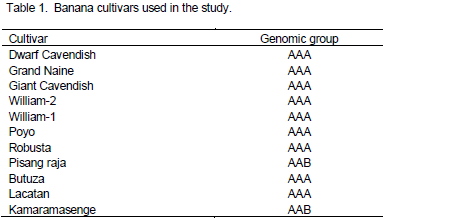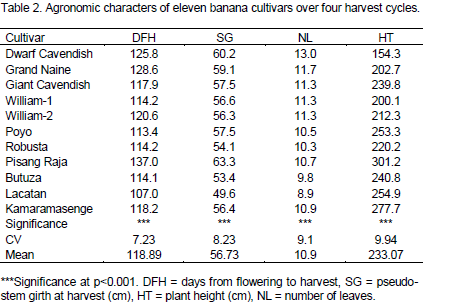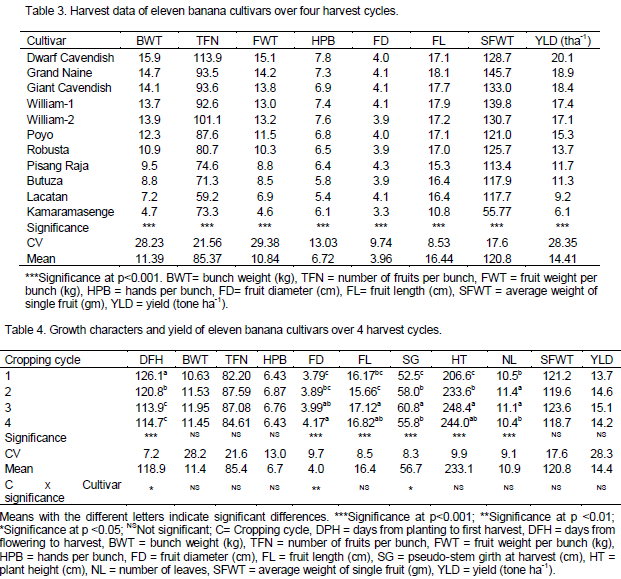ABSTRACT
Eleven dessert banana cultivars were evaluated on vertisols at Pawe for four consecutive cropping cycles. The experiment was established using a randomized complete block design with three replications and analysis of variance and correlation were carried out to examine the yield and morphological adaptation of yield related characters of the cultivars. The cultivars in the study showed a significant difference (p <0.001) for all characters studied in the experiment. The highest fruit yield (20.1 tones ha-1) was recorded for the cultivar, Dwarf Cavendish (AAA) while Kamaramasenge (AAB) was the lowest with a yield of (6.1 tones ha-1). The Cavendish group varieties Grand Naine, Giant Cavendish, William-1 and William-2 were also high yielders with a yield of 18.9, 18.4, 17.4 and 17.1 tones ha-1, respectively, which were on par with dwarf Cavendish. Characters, days from flowering to harvest, fruit diameter and length, pseudo-stem girth, plant height and number of leaves were significantly influenced by the temporal variations in the study. The Pearson correlation coefficient showed that the characters bunch weight (0.97), number of fruits per bunch (0.85), hands per bunch (0.81), fruit length, pseudo-stem girth at harvest, number of leaves and average weight of single fruit (0.74) were positively correlated to yield at p<0.001. The smallest height of Dwarf Cavendish is perceived as excellent feature for orchard management and low wind damage. Moreover, the medium size of the fruit of the cultivar is also a desirable trait. Hence, the variety Dwarf Cavendish is highly recommended to growers along Belese valley of Metekel and Jawe area, while any of the cultivars like Grand Naine, Giant Cavendish and Williams could be used for cultivation. Inherent fruit quality factors of the cultivars should be studied in the future.
Key words: Banana cultivars, Belese valley, fruit yield.
Bananas and plantains constitute the fourth most important global food commodity (after rice, wheat and maize) grown in more than 100 countries over a harvested area of approximately 10 million hectares, with an annual production of 88 million tonnes (Frison and Sharrock, 1999). It provides a starch staple across some of the poorest parts of the world in Africa and Asia, while dessert bananas are a major cash crop in many countries. The all year round fruiting habit of bananas puts the crop in a superior position in bridging the ‘hunger gap’ between crop harvests. It therefore contributes significantly to food and income security of people engaged in its production and trade, particularly in developing countries. In Africa they provide more than 25% of the carbohydrate requirements for over 70 million people (IITA, 1998). The bananas, especially the dessert banana is the major fruit crop in Ethiopia leading both in area and production. In 2010/11 Ethiopian main cropping season (Meher) bananas production was estimated to be 57.78% of the total fruit produced and its production spanned on 31,885.86 ha (58.35%) of the total area covered by fruit crops in the country, while production status in Benishangul Gumuz region is much lower with only 345.26 ha used for banana cultivation (CSA, 2011). Fruit production in Ethiopia is at its infant stage with only 0.41% of the total production area was estimated to be under fruit cultivation (CSA, 2011). Like other agricultural commodities banana production faces several biotic and abiotic constraints and poor provision of production technologies. In resource poor production system, productive varieties that are resistant to pests and diseases are highly suitable for increasing productivity.
Within collections of Musa germplasm worldwide, there are between 1500 and 3000 accessions, representing a wide range of morphological variation and genome constitutions (Heslop-Harrison and Schwarzacher, 2007). The banana cultivars have diversified and complex germplasm pool consisting both the cultivated and wild types. The diversity of new forms derived through a combination of accumulation of somatic mutations and human selection has led Ortiz (1997) to consider sub-Saharan Africa as a secondary centre of banana diversity. Genotypes often interact with the environment in an unpredictable manner (Simmonds, 1991) and as a result selecting genotypes that are tested across locations and/or years to study their adaptation and stability of performance before recommendation is crucial. So, breeding programs should focus on selecting cultivars that are high yielding, disease resistant, abiotic stress resistant and altered agronomic performance for target areas best suited to the cultivars.
In this study, eleven banana cultivars were evaluated at Pawe for four consecutive cropping seasons. The yield and morphological adaptation of yield related characters of the cultivars were examined.
Eleven dessert banana cultivars (Table 1) were established at Pawe in 2006. The cultivars were grown on vertisol, soil with high smectitic clay content. The area is characterized by a unimodal rainfall pattern receiving average annual rainfall of 1586.4 mm. The maximum and minimum temperatures of the area are 32.6 and 16.4°C respectively with average relative humidity of 55%. The experiment was established using a randomized complete block design with three replications. Four plants were maintained on each plot with spacing of 3 m between the rows and 2.5 m within rows, giving a planting density of 1333 plant per hectare. All management practices were carried out following standard recommendations and supplemental irrigation was provided during the off season.

Data were taken for four consecutive cropping cycles on number of leaves, pseudo-stem girth at 0.5 m height (cm), plant height at each cycle of harvest (cm), days from flower to harvest, bunch weight (kg), hands per bunch, fruit number, fruit weight per bunch (kg), fruit diameter (cm), fruit length (cm), average weight of single fruit (gm), marketable fruit number and weight, yield per hectare (estimated from plot yield) in ton ha-1. Analysis of variance and correlation among the traits were carried out using PROC GLM and PROC CORR procedure of SAS software respectively (SAS, 2002).
The cultivars in the study showed a significant difference (p <0.001) for yield and related morphological characters (Table 3). The highest fruit yield (20.1 ton ha-1) was recorded for dessert banana variety Dwarf Cavendish while Kamaramasenge was the least with a yield of (6.1 tons ha-1). The Cavendish sub group varieties Grand Naine, Giant Cavendish, William-1 and William-2 were also high yielders with a yield of 18.9, 18.4, 17.4 and 17.1 tons ha-1 respectively, which were on par with dwarf Cavendish. Dwarf Cavendish recorded the highest value for morphological characters bunch weight, number of fruits, hands per bunch and a standalone performance in number of green leaves with values of 15.9 kg, 113.9, 7.8 and 13.0 respectively. The cultivar was also the recoded the lowest significant height of 154.3 cm.
The varieties Kamaramasenge and Pisang raja which belongs to genomic group (AAB) were characterized by large height (301.2 and 277.7 cm), low bunch weight (9.5 and 4.7 kg) and small fruits with 113.4 and 55.8 g, weight respectively. Kamaramasenge was also characterized with small fruits which were only 3.3cm in diameter and with a length 10.8 cm. Moreover, the yield of these cultivars were significantly lower than the Cavendish sub group (Grand Naine, Giant Cavendish, William-1, William-2 and Poyo), which constitute (AAA) genome (Table 2). The yield of the cultivars Butuza and Lacatan was also significantly lower than the best performing cultivars with a yield of 11.3 and 9.2 tons ha-1 respectively. As depicted in (Table 2) the agronomic characters days from flowering to harvest, fruit diameter and length, pseudo-stem girth, plant height and number of leaves were significantly influenced by the temporal variations in the study. The yield related characters bunch weight, number of hand and fruits per bunch, average weight of single fruit and the yield remained unaffected by the seasonal change. The cropping cycles showed a significant interaction with the cultivars performance for the plant characters days from flowering to harvest, fruit diameter and pseudo-stem girth.

The Pearson correlation coefficient (Table 5) showed that the characters bunch weight (0.97), number of fruits per bunch (0.85), hands per bunch (0.81), fruit length, pseudo-stem girth at harvest, number of leaves and average weight of single fruit (0.74) were positively correlated to yield at (p<0.001) while plant height showed a significant (p<0.001) low magnitude negative correlation (-0.29). The plant height also exhibited a significantly (p<0.001) low negative correlation with bunch weight, number of fruits per bunch, hands per bunch and fruit length, while it recorded a significant (p<0.001) low positive correlation with pseudo-stem girth (0.32). The number of fruit per bunch was more correlated with fruit diameter (0.92) than fruit length (0.37), while the bunch weight (0.67) and average weight of single fruit weight (0.85) were more correlated with fruit length.
In the study, the effect of the genotypes were significant (p <0.001) on yield and yield component characters while cropping cycle only influenced the characters days from flowering to harvest, fruit diameter and length, pseudo-stem girth, plant height and number of leaves while other characters remain unaffected by the temporal variation. Varied responses of morphological characters were recorded by other authors that most yield components are both influenced by genotypes and cropping cycles with different magnitudes. Tenkouano and Baiyeri (2007) have reported that both genotypes and cropping cycle significantly influence the performance of yield and other growth characters in banana cultivars. In a similar study the cropping cycle affected growth and yield parameters, except the number of days from flowering to maturity (Karamura et al., 2008). The genotype and cropping cycle interactions were not significant for yield and most of yield components (Table 4) indicating that the genotypes are stable and can sustain reasonable amount of yield regularly.

The cultivars under Cavendish group of dessert bananas, Dwarf Cavendish, Giant Cavendish, Grand Naine and other variants, such as Williams have showed insignificant differences in their yield and other yield components like bunch weight and finger length (Table 3) as they are believed to be somatic clonal variants with only some detectable changes between the group at DNA level (Heslop-Harrison and Schwarzacher, 2007).
Yield is a complex character that is largely dependent on many growth characters which are mainly governed by additive gene action (Table 3). In the study most growth and fruit characters have showed a significant correlation among themselves and yield (Table 5) with the exception of plant height. Baiyeri et al. (2000) also found the same result as most of fruit characters were related to the yield but with varied magnitude and the correlation was affected by the genomic group and environment; these effects might explain the consistent and significant low magnitude correlation of plant height with other growth characters and yield.
In the study, the Cavendish group varieties, Dwarf Cavendish, Grand Naine, Giant Cavendish, and other variants, such as Williams gave the highest yield with insignificant differences among themselves. The smallest height of Dwarf Cavendish is perceived as excellent feature for orchard management and low wind damage. Moreover, the medium size of the fruit of the cultivar is also a desirable trait. Hence, the variety Dwarf Cavendish is highly recommended to growers in Metekel zone, while any of the cultivars like Grand Naine, Giant Cavendish and Williams could be used for cultivation. The authors want to emphasize that different inherent fruit quality factors of the cultivars should be studied in the future.
The authors have not declared any conflict of interest.
REFERENCES
Baiyeri KP, Tenkouanoa B, Mbahb BN, Mbagwub JSC (2000). Ploidy and genomic group effects on yield components interaction in bananas and plantains across four environments in Nigeria. Scientia Horticult. 85:51-62.
Crossref |
|
|
|
CSA (2011). Report on area and production of major crops. The Federal Democratic Republic of Ethiopia Central Statistical Agency. Statistical Bulletin. Vol. 1. Addis Ababa. |
|
|
|
Frison E, Sharrock S (1999). The economic, social and nutritional importance of banana in the world. In: Picq C, Foure E, Frison EA (Eds). Banana and Food Security International Symposium, Douala, Cameroon, 10-14 November. |
|
|
Heslop-Harrison JS, Schwarzacher T (2007). Domestication, genomics and the future for banana. Annals of Botany 100:1073–1084.
Crossref |
|
|
|
IITA (1998). Plantain and Banana Improvement Program-Annual Report for 1997. International Institute of Tropical Agriculture, Onne, Nigeria. |
|
|
|
Karamura EB, Gaidashova SV, Karemera F (2008). Agronomic performance of introduced banana varieties in lowlands of Rwanda. Afr. Crop Sci. J. 16(1):9-16. |
|
|
Ortiz R (1997). Morphological variation in Musa germplasm. Genetic Resources and Crop Evolution 44:393-404.
Crossref |
|
|
|
SAS Institute Inc. (2002). Cary. NC. USA. |
|
|
Simmonds NW (1991). Selection for local adaptation in plant breeding programme. Theoret. Appl. Genet. 82:363-367.
Crossref |
|
|
|
Tenkouano A, Baiyeri KP (2007). Adaptation pattern and yield stability of banana and plantain genotypes grown in contrasting agro-ecologies in Nigeria: African Crop Science Conference Proceedings. 8:377-384. |



